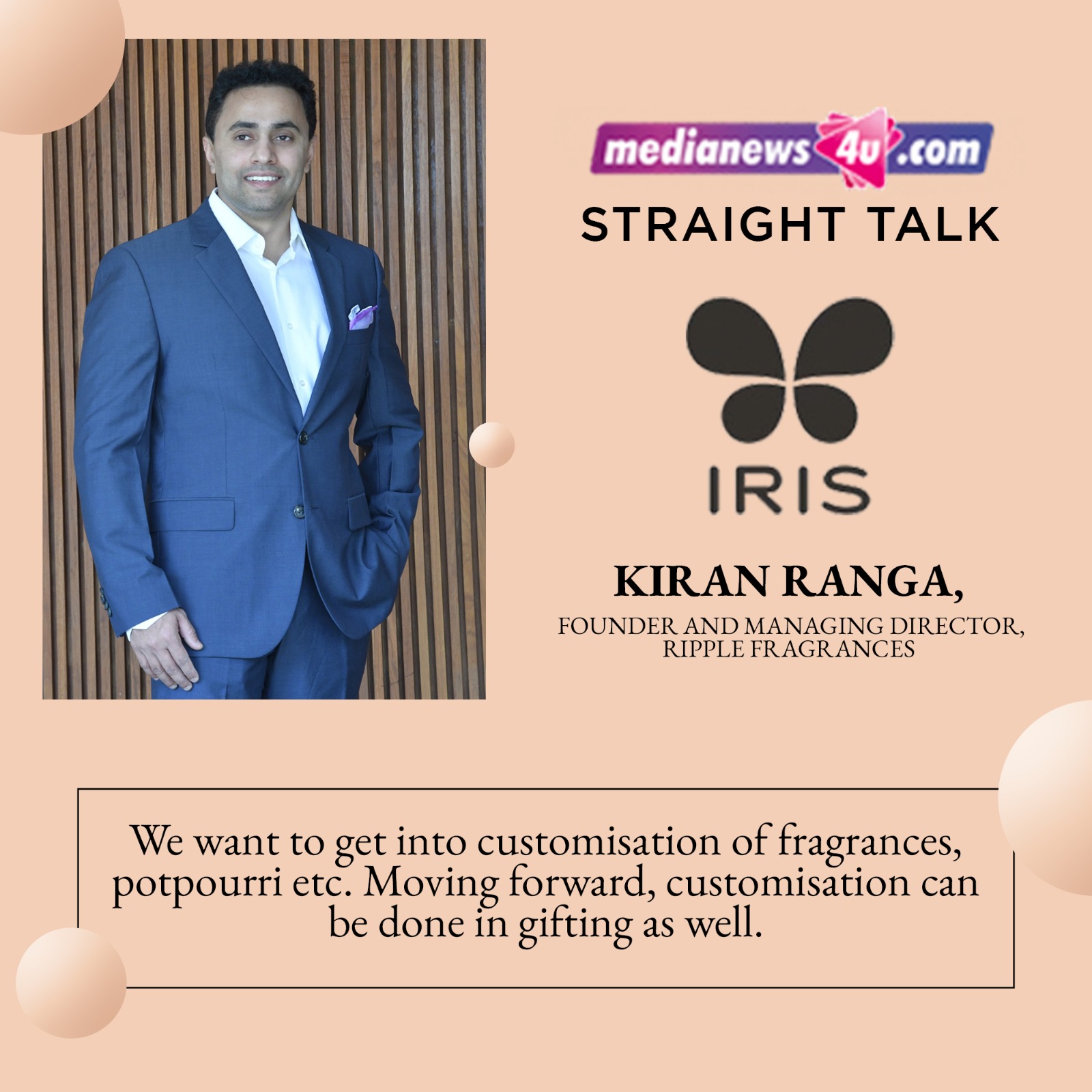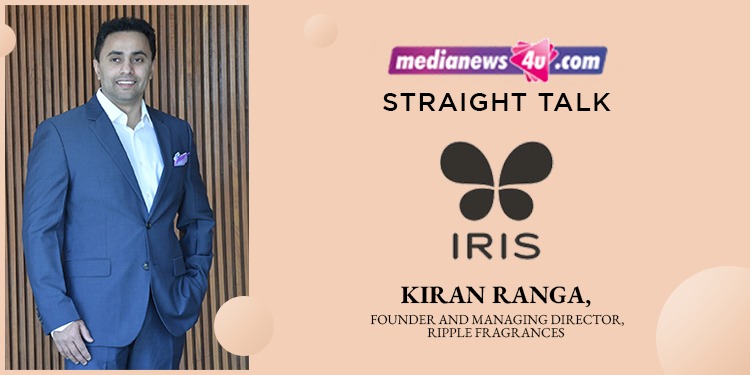Kiran Ranga, Founder and Managing Director, Ripple Fragrances is a third-generation businessman from the Mysore-based NR Group, whose flagship brand is Cycle Pure Agarbathies.
Ripple Fragrances was born to address the opportunity beyond the prayer rooms that Cycle caters to, in the home fragrances space.
The company has in its fold brands Iris and Lia. Iris is in the wellness fragrance space and Lia in the functional fragrance space.
“One of the key competences of Ripple Fragrances is that we create our own fragrances,” underlines Ranga, in a conversation with Medianews4u.com.
He enlists three pillars of strength of R&D for Iris as – fragrance design, product design and the delivery system design (like spray). Once there is a design concept, Ripple works with artisans across the country. There are 600 members in its design team.
“When it comes to fragrances creation, it’s a mix of art and science. Art is creating something that is relevant to the Indian consumer, and science is getting something that will work in the kind of product that you want,” he explains. Read edited excerpts from the interaction below.
Ripple was founded in 2004 and Iris in 2008. What have been the milestones for the division and the brand since 2008? How big is Ripple today? How is Iris growing?
When we launched the brand, we were pioneers in the home fragrance market. We have developed different channels for it.
Iris is available in about 5,000 retail outlets today. Our focus on Iris will be different channels. We will be focusing on mass market outlets like DMart, Reliance Smart Bazaar, Spar etc. Apart from this, we are in home décor and home improvements space like Home Centre, Evoke, @Home etc. We will also be present in the hypermarket sections of different chains where Home Décor will be a part. Now the brand acceptance has gone beyond that. We are present in grocery and other markets.
As a brand Lia has been existing for the last three decades. Cycle is positioned as a brand for prayer and hope. When we launched Lia agarbathis, the objective was to create a brand for ambience. We did an extension of Lia in the room fragrance category around 2012-’13. In Lia today we have room and car fragrances, car and dash gel, and more.

Iris has products include reed diffusers, scented candles, tea light diffusers, fragrance vaporisers, garden agarbathis and pillow misters. Is there anything else? Which are the largest selling product categories?
A very interesting product we have is the ultrasonic mister. It doesn’t need any source of heat. The water and fragrance combination, because of the ultrasonic vibration in the equipment, forms a fine mist which is spread in the air.
The largest categories would be Rediffusers, candles, potpourri, and fragrance vaporisers.
Within Iris you have Iris, Celeste, Amogha, which all offer aromatic candles and the like. How is each different from each other in terms of pricing? Who is each targeted at?
When we started Iris range, it was a mid-market offering. An entry level offering where we have a price point ranging from approximately Rs.100 to Rs.600. For Celeste, we have taken the entry level up from Rs.550 going upto Rs.4,000. The idea here is we have fragrances which are more evolved, we have accessories which compliment décor in more premium sector households.
Then there is Botanics and Bliss. What are these products and how are they priced?
Botanics is a new range which is between Celeste and Iris. With Botanics there is an increasing trend towards products which have natural botanical infusions including soya wax candles. We have bottled candles which are priced at Rs.345, rediffusers at Rs.650. The range will be anywhere between Rs.300 and above.
Bliss gift packs are priced at Rs.2,500.
What are the different distribution channels for the above?
We don’t follow the traditional FMCG model. We try to understand where our consumers are shopping for these kinds of products. As mentioned earlier, home décor showrooms are very important for us. For Iris, mass merchandise outlets are important. When it comes to regular retail, we will be more focused on gift stores, in some cases flower boutiques where our consumers shop for gifts and wellness products. We focus on depth rather than width.
You have launched a festive campaign for Iris Celeste around gifting. How much does gifting contribute to sales?
We are not a pure gifting company, but in recent times gifting online has been very significant. Currently gifting would contribute to around 28 pc of sales, but I see this increasing. We will be looking very aggressively at gifting occasions and creating festive products around gifting.
Is this the first time Iris has engaged celebrities? How has it worked for the brand so far?
When we get into the gifting space, especially online, we wanted to create some level of credibility because awareness in this category is very important. We were looking out and were particular about onboarding a celebrity couple. We believe during the festive season the decision of gifting your loved ones is taken together as a couple. Hence Neha Dupia and Angad Bedi are a perfect fit for the objective. This is a year-long campaign. It has kicked off in the right way.
You have opened Iris Aroma Boutique . How has the reception to the store been?
Our first flagship store was launched in Bangalore back in 2012. The number of stores is nine. The idea here with our stores is where people can walk in and shop many home fragrances under one roof. The exciting part is that we created a base of loyal consumers who keep coming back for our home fragrances. It tells us that they are using the products in their everyday life.
Another thing we wanted to do in home fragrances as we evolve is we want to offer more customised offerings for our consumers. We want to get into customisation of fragrances, potpourri etc. Moving forward, customisation can be done in gifting as well.

Is the audience profile between online and offline sales channels any different?
Generally, in India the online consumer profile is younger in terms of age, but in terms of lifestyle and wellness the parameters will be the same. We are looking at consumers who are looking at fragrances as a form of destressing or on special occasions or celebrations.
Especially post the pandemic, people are looking for fragrances also for wellness and holistic living.
How often do you launch new fragrances? What kind of research and gestation goes into developing them?
As a creative perfumer, I will be working on new perfumes based on trends or marketing briefs. From which, under every brand we launch about 10 to 15, which is like 30 to 35 fragrances every year.
We will not just keep adding on to the basket; we will keep taking out some of the fragrances which are not performing or not in trend.
Iris has its own website, also available on online marketplaces. How is the online revenue split between these?
Currently, our contribution from online marketplaces is like 80 pc. We are also looking to be aggressive on our D2C platform.
Are there any broader trends you have observed in the home fragrance sector, globally? Any that you expect to spill over into India?
One thing I have observed is that post-Covid era, the affinity for fragrances for wellness, better emotions, and positivity are trending a lot. In recent times, we can see people using natural ingredients in the fragrance space. It is a trend seen in India as well. Using natural supplements, extract for personal care is on the high, natural ingredients for home care is also there.
Also, there is an increase of air conditioned spaces in India, because of increase in temperature and quality of air. As it can get claustrophobic, there is always a need for fragrance. Globally, there is an increase of fragrances in different formats in indoor spaces. This is observed in India as well.
Iris hasn’t been seen in mass media as much as Cycle. How different is the marketing approach? How has the brand been built?
With Iris, as I mentioned earlier, the penetration is about 5,000 outlets. As the penetration is less, then the cost of reaching out to the consumers through mass media will be high. We resort to digital, online, specific lifestyle publications, insertions in inflight magazines etc. Our endeavour is to increase the penetration from 5,000 outlets. With that the use of media channels also will be widened.

















